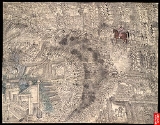
Najib-ul-Daula
Encyclopedia
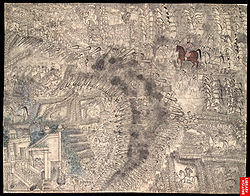
Rohilla
The Rohilla are a community of Hindi-speaking Pashtun also known as Pathan, historically found in the state of Uttar Pradesh, in North India. Most are now also found in Pakistan where they are now part of the Mohajir community. At one time, they form one of the largest Pashtun diaspora community...
tribal chief in 18th century Rohilkhand
Rohilkhand
Rohilkhand is a region of northwestern Uttar Pradesh state of India.Rohilkhand lies on the upper Ganges alluvial plain and has an area of about 25,000 km²/10,000 square miles...
, who in the 1740s founded the city of Najibabad
Najibabad
Najibabad is a pleasant city / partially hill station and a municipal board in Bijnor district in the Indian state of Uttar Pradesh. It has a railway junction and is one of the administrative blocks of the Bijnor district...
in Bijnor district
Bijnor District
Bijnor is a district of Uttar Pradesh state of India. Bijnor city is the district headquarters.-Geography :...
, India
India
India , officially the Republic of India , is a country in South Asia. It is the seventh-largest country by geographical area, the second-most populous country with over 1.2 billion people, and the most populous democracy in the world...
, and succeeded Safdar Jang as Nawab Wazir of the Mughal Empire
Mughal Empire
The Mughal Empire , or Mogul Empire in traditional English usage, was an imperial power from the Indian Subcontinent. The Mughal emperors were descendants of the Timurids...
. Later in his career he was known as Najib-ud-daula, Amir-ul-umra, Shuja-ud-daula.From 1757 to 1770 he was governor of Saharanpur
Saharanpur
Saharanpur is a city and a Municipal Corporation in the state of Uttar Pradesh in northern India. It is the administrative headquarters of Saharanpur District as well as Saharanpur Division...
, ruling over Dehradun
Dehradun
- Geography :The Dehradun district has various types of physical geography from Himalayan mountains to Plains. Raiwala is the lowest point at 315 meters above sea level, and the highest points are within the Tiuni hills, rising to 3700 m above sea level...
. Many architectural relics of the period of Rohilla he oversaw remain in Najibabad, which he founded at the height of his career as a Mughal
Mughal Empire
The Mughal Empire , or Mogul Empire in traditional English usage, was an imperial power from the Indian Subcontinent. The Mughal emperors were descendants of the Timurids...
minister.
Biography
Najib Khan belonged to the umarkhel section of Mandanhs. He migrated from SwabiSwabi
Swabi is the capital of Swabi District in the Khyber Pakhtunkhwa province of Pakistan. It is located at 34°7'0N 72°28'0E. Its residents are referred to as 'Swabiwaal.'-Geography:...
, Afghanistan
Afghanistan
Afghanistan , officially the Islamic Republic of Afghanistan, is a landlocked country located in the centre of Asia, forming South Asia, Central Asia and the Middle East. With a population of about 29 million, it has an area of , making it the 42nd most populous and 41st largest nation in the world...
now in Pakistan in the northwest to Rohilkhand
Rohilkhand
Rohilkhand is a region of northwestern Uttar Pradesh state of India.Rohilkhand lies on the upper Ganges alluvial plain and has an area of about 25,000 km²/10,000 square miles...
in 1739 to join his uncle Bisharat Khan, who had settled with his band of Pathans at Bisharatnagar, near Rampur
Rampur, Uttar Pradesh
Rampur is a city and a municipality located in Rampur District in the Indian state of Uttar Pradesh. Rampur district is located at Longitude 78-0-54 to 69-0-28 East and Latitude 28-25 to 29-10 North and spans an area of 2,367 km².It also gave its name to a former princely state of British...
. In 1749, Ali Mohammed, who had captured most of Rohilkhand
Rohilkhand
Rohilkhand is a region of northwestern Uttar Pradesh state of India.Rohilkhand lies on the upper Ganges alluvial plain and has an area of about 25,000 km²/10,000 square miles...
by 1740, gave Najib Khan a northern portion , where he established the present day city of Najibabad
Najibabad
Najibabad is a pleasant city / partially hill station and a municipal board in Bijnor district in the Indian state of Uttar Pradesh. It has a railway junction and is one of the administrative blocks of the Bijnor district...
, a state of Najibabad
Najibabad
Najibabad is a pleasant city / partially hill station and a municipal board in Bijnor district in the Indian state of Uttar Pradesh. It has a railway junction and is one of the administrative blocks of the Bijnor district...
independent from other Rohilla tribes, and received the title, ‘Najib-ud-daula’.
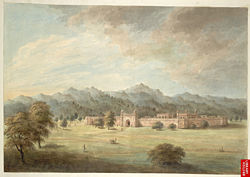
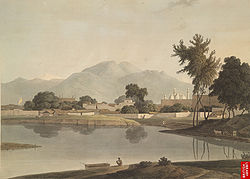
Saharanpur
Saharanpur is a city and a Municipal Corporation in the state of Uttar Pradesh in northern India. It is the administrative headquarters of Saharanpur District as well as Saharanpur Division...
under Mughal Empire
Mughal Empire
The Mughal Empire , or Mogul Empire in traditional English usage, was an imperial power from the Indian Subcontinent. The Mughal emperors were descendants of the Timurids...
, invaded the city of Dehradun
Dehradun
- Geography :The Dehradun district has various types of physical geography from Himalayan mountains to Plains. Raiwala is the lowest point at 315 meters above sea level, and the highest points are within the Tiuni hills, rising to 3700 m above sea level...
, with his army of Rohillas, and ruled the area for the next decade. His rule was known for its administration, and development of land resources, leading to wide spread development and prosperity in the area, with emphasis on agriculture and irrigation. Many mango groves created during the area still exist today. Though after his death in 1770, the area again fell into the hands of warring sides of Raj puts, Gujjars, Sikhs and Gurkhas, who successively ruled the region, leading to its downfall
Third Battle of Panipat – 1761
In the Third battle of PanipatThird battle of Panipat
The Third Battle of Panipat took place on 14 January 1761, at Panipat , about 60 miles north of Delhi between a northern expeditionary force of the Maratha Confederacy and a coalition of the King of Afghanistan, Ahmad Shah Abdali with 2 Indian Muslim allies—the Rohilla Afghans of the Doab, and the...
, during the Imperial Maratha Conquests
Imperial Maratha Conquests
The Imperial Maratha Conquests were a series of conquests in the Indian subcontinent which led to the building of the Maratha Empire. These conquests were started by Shivaji Maharaj in 1659 from the victory at the Battle of Pratapgad...
, he allied himself with the Durranis led by Ahmad Shah Durrani
Ahmad Shah Durrani
Ahmad Shah Durrani , also known as Ahmad Shāh Abdālī and born as Ahmad Khān, was the founder of the Durrani Empire in 1747 and is regarded by many to be the founder of the modern state of Afghanistan.Ahmad Khan enlisted as a young soldier in the military of the Afsharid kingdom and quickly rose...
(also known as Ahmad Shah Abdali , against the Maratha
Maratha
The Maratha are an Indian caste, predominantly in the state of Maharashtra. The term Marāthā has three related usages: within the Marathi speaking region it describes the dominant Maratha caste; outside Maharashtra it can refer to the entire regional population of Marathi-speaking people;...
s. Najib Khan was shrewd enough to understand changed ground realities after third battle of Panipat
Third battle of Panipat
The Third Battle of Panipat took place on 14 January 1761, at Panipat , about 60 miles north of Delhi between a northern expeditionary force of the Maratha Confederacy and a coalition of the King of Afghanistan, Ahmad Shah Abdali with 2 Indian Muslim allies—the Rohilla Afghans of the Doab, and the...
.
His cunning political acumen was used by Ahmed Shah Abdali to isolate Marathas & preventing them from getting even single ally during their conflict with Durrani power. His opposition to signing of treaty, with Marathas was the main cause of battle being fought at Panipat. He not only provided, Ahmed Shah Abdali, with 40,000 Rohilla troops but also 70 guns to the combined forces. He also convinced Shuja-ul-Daula, the Nawab of Oudh, to join Ahmad Shah Abdali's forces against the Marathas. In this battle, the Maratha's were defeated and as a consequence Rohilla increased in power.
After the war he was made vizier
Vizier
A vizier or in Arabic script ; ; sometimes spelled vazir, vizir, vasir, wazir, vesir, or vezir) is a high-ranking political advisor or minister in a Muslim government....
of Mughal emperor. . He had to become vizier of Delhi state with empty treasury & territory confining to boundaries of Delhi city .He negotiated bought peace with Marathas in 1768 by surrendering Doab
Doab
A Doab is a term used in India and Pakistan for a "tongue" or tract of land lying between two confluent rivers...
.
Najib Khan was an Afghan soldier of fortune; he attained the hand of the daughter of Dunde Khan, one of the chieftains of the Rohilkhand
Rohilkhand
Rohilkhand is a region of northwestern Uttar Pradesh state of India.Rohilkhand lies on the upper Ganges alluvial plain and has an area of about 25,000 km²/10,000 square miles...
Pathans. Rewarded by this ruler with the charge of a district, now Bijnor
Bijnor
Bijnor variously spelt as Bijnaur and Bijnour, is a city and a municipal board in Bijnor district in the state of Uttar Pradesh, India...
, in the North-west corner of Rohilkhand
Rohilkhand
Rohilkhand is a region of northwestern Uttar Pradesh state of India.Rohilkhand lies on the upper Ganges alluvial plain and has an area of about 25,000 km²/10,000 square miles...
, he had joined the cause of Safdarjung
Safdarjung
Safdarjung was the Subadar Nawab of Oudh from 19 March 1739 to 5 October 1754.-Life:Safdarjung was born as Muhammad Muqim in Khurasan, Persia and migrated to India in 1722.-Career:...
, when that minister occupied the country; but on the latter's disgrace had borne a part in the campaigns of Ghazi-ud-din. When the Vizier first conceived the project of attacking the government, he sent Najib in the command of a Mughal detachment to occupy the country, about Saharanpur, then known as the Bawani Mahal, which had formed the jagir of the Ex-Vazir Khan Khanan.
This territory thus became in its turn separated from the Empire, and continued for two generations in the family of Najib. He ruled the dwindled Empire for nine years, and died a peaceful death, leaving his charge in an improved and strengthened condition, ready for its lawful monarch. He was highly esteemed by the British in India.
After the war
RohilkhandRohilkhand
Rohilkhand is a region of northwestern Uttar Pradesh state of India.Rohilkhand lies on the upper Ganges alluvial plain and has an area of about 25,000 km²/10,000 square miles...
was invaded by the Maratha
Maratha
The Maratha are an Indian caste, predominantly in the state of Maharashtra. The term Marāthā has three related usages: within the Marathi speaking region it describes the dominant Maratha caste; outside Maharashtra it can refer to the entire regional population of Marathi-speaking people;...
s to retaliate against the Rohilla
Rohilla
The Rohilla are a community of Hindi-speaking Pashtun also known as Pathan, historically found in the state of Uttar Pradesh, in North India. Most are now also found in Pakistan where they are now part of the Mohajir community. At one time, they form one of the largest Pashtun diaspora community...
participation in the Panipat
Panipat
Panipat بَنِبَت is an ancient and historic city in Panipat district, Haryana state, India. It is 90 km north from Delhi and 169 km south of Chandigarh on NH-1. The three battles fought at the city were turning points in Indian history. The city is famous in India by the name of "City of...
War. Eventually, he made a pact with the Marathas, who rose to power in 1769-70, in 1770, he advanced with Maratha army under, Scindias and Holkar
Holkar
The Holkar dynasty , whose earliest known clan-man was Malhar Rao, who joined the service of the Peshwa in 1721, and quickly rose to the ranks of Subedar...
s, and went on to defeat Rahmat Khan
Hafiz Rahmat Khan
Hafiz Rahmat Khan was Regent of Rohilkhand in North India, from 1749 to 1774. He was a Pashtun by background, ruling over Rohillas ....
, the Nawab of Rohilkhand
Rohilkhand
Rohilkhand is a region of northwestern Uttar Pradesh state of India.Rohilkhand lies on the upper Ganges alluvial plain and has an area of about 25,000 km²/10,000 square miles...
, who has earlier made himself, the head of Etawah
Etawah
Etawah is a city on the Yamuna River in the state of Uttar Pradesh in India. It is the administrative headquarters of Etawah District. The city was an important center for the Revolt of 1857 . Also is the place of sangam or confluence between Yamuna and Chambal...
, after the Third Battle of Panipat
Third battle of Panipat
The Third Battle of Panipat took place on 14 January 1761, at Panipat , about 60 miles north of Delhi between a northern expeditionary force of the Maratha Confederacy and a coalition of the King of Afghanistan, Ahmad Shah Abdali with 2 Indian Muslim allies—the Rohilla Afghans of the Doab, and the...
1761. , but he soon fell ill and died on October 30, 1770/
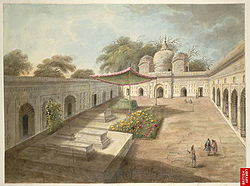
Zabita Khan
Zabita Khan Rohilla was Rohilla chieftain in the time of the Mughal Emperor Shah Alam . He was the son of the Rohilla Sardar Najib-ud-Daula, who founded the city of Najibabad, Zabita Khan is also known to have fought alongside his father during the Battle of Panipat...
. His cemetery is still in present day, Najibabad
Najibabad
Najibabad is a pleasant city / partially hill station and a municipal board in Bijnor district in the Indian state of Uttar Pradesh. It has a railway junction and is one of the administrative blocks of the Bijnor district...
, where the Patthargarh Fort still exists.
A few years later, in the subsequent Rohilla War
Rohilla War
The First Rohilla War of 1773-1774 was a punitive campaign by Shuja-ud-Daula, Nawab of Awadh, against the Rohillas, Afghan highlanders settled in Rohilkhand, northern India...
, the Rohillas were attacked by Awadh
Awadh
Awadh , also known in various British historical texts as Oudh or Oude derived from Ayodhya, is a region in the centre of the modern Indian state of Uttar Pradesh, which was before independence known as the United Provinces of Agra and Oudh...
with help from British East India Company
British East India Company
The East India Company was an early English joint-stock company that was formed initially for pursuing trade with the East Indies, but that ended up trading mainly with the Indian subcontinent and China...
forces. When Hafiz Rahmat Khan
Hafiz Rahmat Khan
Hafiz Rahmat Khan was Regent of Rohilkhand in North India, from 1749 to 1774. He was a Pashtun by background, ruling over Rohillas ....
was killed, in April 1774, they were defeated, and Rohilkhand was plundered; and later, the Rohilla power east of the Ganges was crushed, and the final treaty by which the territory was incorporated in Awadh
Awadh
Awadh , also known in various British historical texts as Oudh or Oude derived from Ayodhya, is a region in the centre of the modern Indian state of Uttar Pradesh, which was before independence known as the United Provinces of Agra and Oudh...
was concluded at Lal Dhang
Lal Dhang
Laldhang is a town in Haridwar district of Uttarakhand, 19.4 km from Haridwar, and 27 km from Kotdwar.-Geography:Laldhang is located at . It has an average elevation of...
. The District was ceded to the British by the Nawab of Awadh
Nawab of Awadh
The Nawab of Awadh is the title of rulers who governed the state of Awadh in India in the 18th and 19th century. The Nawabs of Awadh originated form Persia-Establishment:...
, Saadat Ali Khan II in 1801 .
Further reading
- Najib-ud-Daula at Dehli The Fall of the Moghul Empire of Hindustan, by H. G. Keene. 1887, Part II, Chapter II, 1764.

